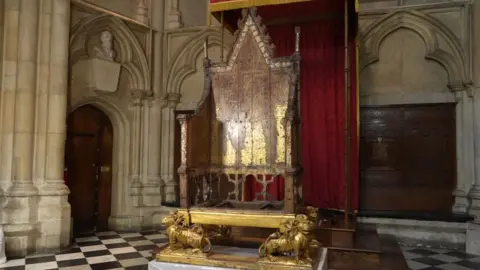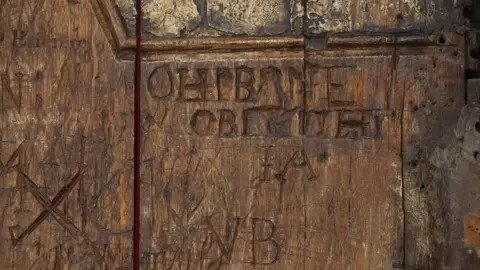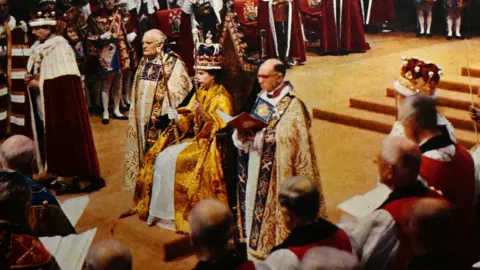Extremely fragile coronation chair being restored
 PA Media
PA MediaThe medieval chair used in the coronation of monarchs is undergoing conservation work, in order to be ready for the crowning of King Charles III.
The 700-year-old oak chair is described as "extremely fragile" by conservation experts at Westminster Abbey.
The painstaking preservation work is intended to clean the chair and stabilise layers of flaking gilding.
It's part of the preparations for the coronation ceremony to be held at the Abbey in London on 6 May.
The historic coronation chair, a centrepiece of the ceremony for centuries, is a "unique work of art", says conservator Krista Blessley.
"It's the oldest surviving piece of furniture still used for its original purpose," she says.
 Duncan Stone
Duncan StoneIt was made on the orders of Edward I, who reigned from 1272 to 1307, and it has been used in almost every coronation ceremony since then.
But Ms Blessley says "it's not a museum piece" and has faced some hard knocks.
Tourists and schoolchildren scarred it with graffiti in the 18th and 19th Century.
"P. Abbott slept in this chair 5-6 July 1800" is among the letters carved into the chair, which will be used by King Charles at the ceremony in May.
Subsequently, the chair was damaged in a bomb attack in 1914, attributed to suffragettes campaigning for votes for women.
"It's extremely fragile. It has a complex layer structure, which means the gilding layers often flake off, so a lot of my work is sticking those layers of gilding back down, making sure it's completely sound before the coronation," says Ms Blessley.
 Duncan Stone
Duncan StoneThe conservator has already been working on the chair for four months.
"If there are little changes in humidity the wood moves, and that complex layer structure moves - new areas will lift. I might consolidate something this month, then in two months I might need to consolidate it again," says Ms Blessley.
But she's very proud to be working on such an "exquisite example" of medieval craftsmanship, including finding a previously unrecognised design of toes on the back of the chair.
In its original medieval form, the chair was covered with gold leaf gilding and coloured glass, with patterns of birds, foliage, animals, saints and a king.
The chair was designed to enclose the Stone of Scone, which had been seized from Scotland by Edward I - and the stone, which is currently in Edinburgh, is expected to be brought back to Westminster Abbey for the coronation.
 Universal History Archive
Universal History ArchiveDr George Gross from King's College London is part of a research project into the history of coronations.
In recent coronations the high-backed gothic chair has been left uncovered, but he says in the Tudor and Stuart eras it would have been covered by a lavish cloth of gold.
The coronation has a strong religious element, and Dr Gross highlights the sense of the ancient chair having acquired its own sacred status - as a "deeply mystical relic" - which was seen as "emitting a form of spiritual radioactivity".
Details have begun to emerge about the coronation ceremony for King Charles III, including 12 new pieces of specially-composed music, with an anthem by Andrew Lloyd Webber.
The ceremony is expected to be a shorter and more inclusive service than in 1953, with about 2,000 guests, rather than the 8,000 who attended the late Queen's coronation.
Camilla, the Queen Consort, will be crowned alongside the King, but it's been revealed that her crown will not include the controversial Koh-i-Noor diamond.
It's not yet known who will be invited to the ceremony, with particular interest in whether Prince Harry and Meghan, the Duchess of Sussex will be part of the congregation.
What we know about the Coronation long weekend so far:
Saturday 6 May: Coronation service in Westminster Abbey; coronation carriage procession; Buckingham Palace balcony appearance for the Royal Family
Sunday 7 May: Concert and lightshow at Windsor Castle; Coronation Big Lunch street parties
Monday 8 May: Extra bank holiday; Big Help Out encouraging people to get involved in local volunteering projects
